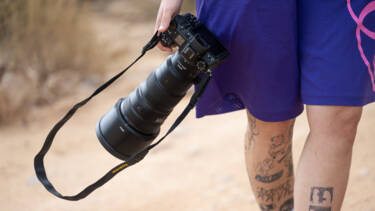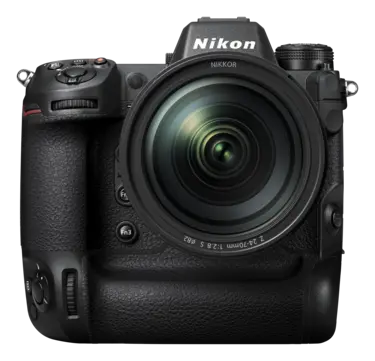Long exposure tutorial for water photography – an advanced step-by-step guide
For magical silky-smooth waterfalls and rivers, the right equipment and techniques are key, says landscape photographer Scott Antcliffe
Long exposure water photography creates those dreamlike, ethereal images where rushing water transforms into a silky, smooth surface while the surrounding landscape remains tack sharp. Want to master water photography? Here’s how.
Here, I wanted to convey a sense of quickness with the water, as it was flowing fairly rapidly at this particular point. I wanted to provide context, include the surroundings, and also used the path to the side as a leading line. I really like the bridge as a focal point. No filters were used for this image. Z9 + NIKKOR Z 14-24mm f/2.8 S, 14mm, 0.5 sec, f/22, ISO 40, ©Scott Antcliffe
Composition first
Before even thinking about settings, carefully consider your composition. Look for strong leading lines, interesting foreground elements (rocks, foliage, reflections) and a balance within the scene. The static elements in your frame are just as crucial as the blurred water. Experiment with different perspectives – get low to the ground, find a higher vantage point and move around to discover the most engaging composition.
Keep an eye on the water entry and exit points as these can create natural visual anchors where the water flows in and out of your frame.
With this image, once again I wanted to show the fast-flowing nature of the cascade. I used the rocks as foreground interest and ensured the water takes you through the scene from left to tight. No filters were used for this image. Z9 + NIKKOR Z 14-24mm f/2.8 S, 24mm, 0.6 sec, f/22, ISO 40, ©Scott Antcliffe
Mastering the set-up and settings
The foundation of great long exposure water imagery lies in a meticulous set-up and precise camera settings:
1. Stability is paramount: Any movement during a long exposure will result in unwanted blur across the entire frame, not just the water. A sturdy tripod is non-negotiable. Ensure all legs are firmly planted and consider weighing it down with your camera bag or a dedicated weight, especially in windy conditions. If working on uneven ground, take extra care to secure the tripod.
2. Manual focus precision: Autofocus systems can sometimes struggle with static subjects during long exposures, especially when using Neutral Density (ND) filters, which can darken the viewfinder. Switch to Manual focus and pinpoint focus on your key foreground element or a point of interest within the scene. Once focus is locked, be careful not to accidentally adjust the focus ring. If you then recompose, double check that your frame is in focus.
3. Choosing the right aperture: While the long exposure effect is primarily controlled by shutter speed, aperture still plays an important role. For landscape photography, a mid-range aperture (typically between f/8 and f/16) often provides a good balance between depth of field and image sharpness. Consider the overall scene and adjust accordingly. If you want a shallow depth of field to isolate a foreground element against blurred water, a wider aperture might be considered but be mindful of the reduced area of sharpness.
4. Understanding ISO: Keep your ISO as low as possible (typically ISO 100 or 64, depending on your camera’s base ISO) to minimise noise in your images. Since you’ll be using a tripod and potentially ND filters to extend the exposure time, there’s no need to increase the ISO for brighter images.
In this image, I once again let the water flow from the bottom left corner to the top right on the thirds. I also used a tree and rocks on the far right to hold the frame. A Lee Big Stopper (10 stops) and a Lee Circular Polariser were used. Z9 + NIKKOR Z 24-70mm f/2.8 S, 27.5mm, 30 sec, f/11, ISO 125, ©Scott Antcliffe
5. The crucial shutter speed: This is where the magic happens. The ideal shutter speed for silky smooth water depends on the speed and volume of the water flow and the desired aesthetic. Experimentation is key, but for fast flowing water 1/2 to 2 seconds would be a good starting point. For rivers and gentler falls 2 to 10 seconds would create the classic milky effect.
6. Neutral Density (ND) filters – your exposure control: To achieve long shutter speeds in daylight, you'll need ND filters to reduce the amount of light entering your lens. These filters come in various strengths, denoted by their optical density or f-stop reduction (e.g., ND4, ND8, ND1000). The higher the number, the longer the exposure. I generally use a 6-stop or 10-stop to get the milky, ethereal effect.
7. Metering with ND filters: With a strong ND filter attached, your camera’s built-in meter will likely be inaccurate. Meter the scene without the filter first, noting the suggested shutter speed. Then, use the filter’s stop rating to calculate the required long exposure time. For example, if your meter suggests 1/60th of a second without a 10-stop ND filter, your long exposure will be approximately 10 seconds (1/60 -> 1/30 -> 1/15 -> 1/8 -> 1/4 -> 1/2 -> 1 -> 2 -> 4 -> 8 -> 16 – roughly 10 stops). Many smartphone apps such as Lee Stopper Exposure, Photo Friend, Perfect Exposure and Lightmate are available to help with these calculations.
8. Remote shutter release or self-timer: To eliminate any camera shake caused by pressing the shutter button, use a remote shutter release, the Nikon SnapBridge app, or the camera’s self-timer (2, 5 or 10 seconds).
Essential gear for long exposure water photography
Besides the tripod, ND filters and remote mentioned above, I also take a couple of lens cloths with me, waterproof boots and trousers, and I will sometimes use a polariser. The polarising filter is handy as it reduces reflection on wet rocks and enhances the saturation. It will also reduce light, so this will mean requiring a less strong ND filter or a longer exposure.
In this image, I went for the milky feel, but wanted to photograph a little tighter and lower, adding compression, to make you feel as if you are in the water. I feel the composition works well with the water flowing through the centre of the image. A Lee Big Stopper (10 stops) and a Lee Circular Polariser were used. Z9 + NIKKOR Z 24-70mm f/2.8 S, 49mm, 30 sec, f/11, ISO 400, ©Scott Antcliffe
Subtle enhancements in post-production
While the goal is to capture a strong image in camera, thoughtful post-production can further enhance your long exposure water photographs:
- Basic adjustments: Start with White Balance, exposure, contrast and highlight/shadow adjustments in your preferred editing software.
- Sharpening: Apply selective sharpening to the static elements in your image to enhance detail, while avoiding sharpening the blurred water.
- Colour correction and saturation: Fine-tune the colours to achieve a natural and pleasing look. Be careful not to oversaturate.
- Graduated filters and dodging/burning: Use these tools to subtly balance the exposure across different parts of the image, enhancing details in darker areas or toning down overly bright highlights.
- Noise reduction: If you notice any noise in your long exposure images (especially in darker areas), apply subtle noise reduction.
Long exposure water photography is incredibly rewarding but requires a little patience and experimentation. The main thing is to enjoy the process of capturing the beauty of the scene and enjoy being in the natural surroundings.
More in Travel and Landscape
More by Scott Antcliffe

Unlock greater creativity









